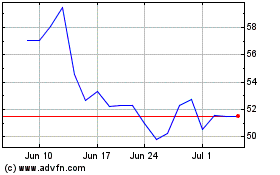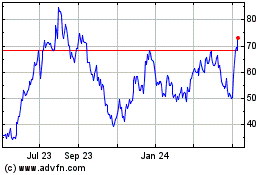Wayfair Copied Amazon to Grow Fast. Now, It Searches for Profits
February 28 2020 - 8:17AM
Dow Jones News
By Sarah Nassauer and Charity L. Scott
For nearly two decades online homegoods seller Wayfair Inc. has
grown quickly by burning through profits.
Now the e-commerce company is trying to show investors it can
moderate its losses as revenue growth slows and investor appetite
for unprofitable companies dries up.
"Ultimately every company needs to be self-financing,"
co-founder and Chief Executive Niraj Shah wrote in an email to
staff earlier this month, explaining his decision to cut about 550
jobs after hiring thousands of people in recent years.
On Friday Wayfair said it lost $330 million in the quarter ended
Dec. 31, more than twice as much as it lost a year earlier.
Quarterly sales rose 26% from a year ago, but operating expenses
jumped 44%. The company's annual net loss nearly doubled to $985
million.
Wayfair isn't like traditional furniture chains such as West Elm
or Ikea, which stock stores and warehouses with curated inventory.
It sells sofas and tables much like Amazon sells books and toys. It
has filled its website with millions of listings and promises free
shipping on much of it.
It spends heavily on marketing to attract web shoppers. It keeps
minimal inventory and often ships directly from suppliers. That has
quickly created a company with more than $9 billion in annual sales
but also with losses every year since it went public in 2014.
It was a formula that investors mostly embraced until recently.
The Boston company's stock tumbled in October after it reported a
steep quarterly loss, and the shares have lost more than 50% of
their value over the past 12 months. The stock fell another 15% in
premarket trading Friday, amid a broader market selloff.
After years of pushing growth, top executives began to
prioritize profitability in presentations to managers late last
year, according to former employees. In one December meeting, Mr.
Shah showed how hiring was growing faster than revenue, said one of
these people. In past group meetings Mr. Shah primarily spoke about
"compounding growth," said this person. A spokeswoman declined to
comment on the meetings.
"Since we founded the company in 2002 we have always had periods
where we invested very heavily in the business and periods where we
have worked to drive greater efficiency," Mr. Shah wrote in his
memo earlier this month. "On reflection this last period of
investment went on too long."
Both startups and public companies have found investors cooling
on companies that don't generate profits since office-rental giant
WeWork's IPO plans unraveled last year. Mattress seller Casper
Sleep Inc. recently had to slash its valuation to go public and its
shares are now trading below the IPO price.
Wayfair's strategy to gain dominance in the online furnishings
category has been to deliver large, bulky items better than their
competitors through supply chain investments, said Brian Nagel, an
analyst at Oppenheimer & Co.
The retailer is following a similar playbook to Amazon.com Inc.
and has taken advantage of cheap capital to "lose money and build a
competitive moat around the business that will help support the
business long term," Mr. Nagel said.
But it is difficult for traditional and online furniture chains
to generate profits amid stiff pricing competition and the high
costs of shipping bulky furniture. Homegoods chain Pier 1 Imports
Inc., which was slow to embrace online sales, filed for bankruptcy
protection earlier this month. In January, Walmart Inc. laid off
most of the headquarters staff at Hayneedle, an online furniture
seller it acquired in 2016, as it works to make its U.S. ecommerce
business more profitable.
Some analysts remain unconvinced that Wayfair can wean itself
from spending. "Revenue growth seems more intertwined with ad
spend, promotions and ongoing investments than the market
appreciates," Morgan Stanley analyst Simeon Gutman said in a note
this week, downgrading the company to the equivalent of a sell
rating.
Tariffs aren't solely to blame for Wayfair's slowing sales, said
Mr. Gutman, but also cluttered assortment and weak sales in
categories such as plumbing and flooring. "The market is less
tolerant of unprofitable online retailers."
Despite the desire of some investors to see Wayfair focus on
profits, the company's leadership can't afford to become complacent
about competition, with both Amazon and Walmart poised to become
more aggressive in the home category, said Colin Sebastian, an
analyst at Robert W. Baird & Co.
"There's just a window of opportunity for them," he said. "So
why would they try to harvest profits when there's a lot more at
stake over the very long term?"
Write to Sarah Nassauer at sarah.nassauer@wsj.com and Charity L.
Scott at Charity.Scott@wsj.com
(END) Dow Jones Newswires
February 28, 2020 08:02 ET (13:02 GMT)
Copyright (c) 2020 Dow Jones & Company, Inc.
Wayfair (NYSE:W)
Historical Stock Chart
From Mar 2024 to Apr 2024

Wayfair (NYSE:W)
Historical Stock Chart
From Apr 2023 to Apr 2024
